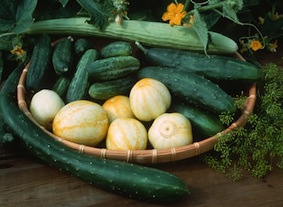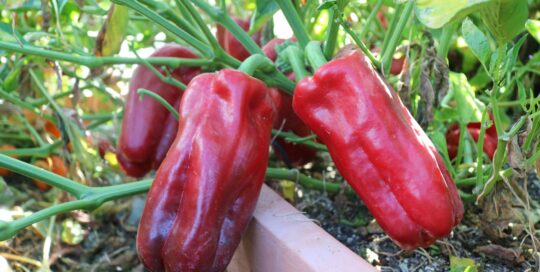This is the Year to Grow Cucumbers
Views: 4526

When I was a kid back on the farm, my father decided to grow an acre or two of cucumbers one summer.
It was a small, odd-angled piece of the farm that would be awkward to harvest with the bigger machinery necessary for potatoes or grain, and he thought cucumbers would be just as good as anything else.
It was the first and only summer Dad grew cucumbers for the local auction house. Growing them was a cinch. It was harvesting that was back-breaking work, and as someone who worked in that field, I can attest to that fact. And those vines hiding all the fruit! No fun.
I haven’t grown cucumbers since. Perhaps the memory of that summer is what keeps me from trying my hand at growing them again.
By say it’s The Year of the Cucumber, the National Garden Bureau is hoping everyone will try growing this recognizable and generally well-liked vining vegetable in gardens and patio pots this year.
Here are a few things the NGB would like you to know about the humble cuke:
Cucumbers are easy to grow
Cucumbers are easy to grow from seed. And they’re easy to grow, period. You can grow cucumbers from seed and sow them indoors to get a jump on the growing season. Or, let the professionals do the job for you and buy ready-to-plant seedlings from your local garden center.
Cucumbers love full sun and light, well-draining soil. For vining types, allow 4 to 5 feet between plants. For dwarf or bush type varieties, the cukes will need just 2 square feet of growing room.
These are very thirsty veggies, so water each plant deeply. Mulching the soil around the cuke will help keep the soil moist. Fertilize with a 5-10-10 fertilizer at the time of planting and monthly throughout their growth.
They’re versatile
Cucumbers are versatile in that they can grow vertically as well as along the ground.
Try planting cucumbers at the base of a trellis and encourage the growing tendrils to vine their way upwards. Growing them so their fruit is off the ground also helps keep the fruit within reach for easier harvesting.
For gardeners with only a patch of patio at their disposal, grow bush cakes in containers and even hanging baskets.
Take Cucumbers sliced or pickled
All cucumbers can be placed in two general categories—slicing or pickling—based on their use. From there they can be further sub-categorized by the way the grow—in a bushy manner or in a vining form.
There are three types of slicing cukes. There’s the Mideastern from Israel, which is burpless and has a smooth, thin skin (more on the burping part later). The second is the Oriental, which has a crisp, sweet taste with a spiny, thin skin. Getting up to 12 inches long, Orientals are often grown on trellises. The third type is the greenhouse cucumber specifically bred for growing in commercial greenhouses (not really a kind you’d grown in a garden).
Pickling cucumbers are mainly used for—you guessed it—pickling and preserving. Some varieties within the pickling category can be used fresh. Pickling cukes are harvested at a smaller stage than slicing types, nothing too much bigger than 5 inches long.
Take them burp or burpless
So, about those “burp” and “burpless” varieties. I always wondered about that myself. According to the NGB, most cucumbers contain something called cucurbitacins, which some think lends a bitter taste to the cuke.
This bitter quality is also associated with the cucumber prompting a burp in some people when eaten. The Oriental cucumbers were described as free of a bitter taste and hence also free of this burp tendency—and the “burpless” cucumber. The burp and burpless (and bitter and bitter-free) all depend on the person and also on the conditions under which the cucumber is grown.
They’ll keep producing
Cucumbers are ready for harvest within 50-65 days. Slicing varieties will be ready when they are 6-8 inches long; pickling varieties are ready at 1-5 inches long. They’re like zucchini in that once they start coming in, you should pick them early and often. Otherwise, you’ll end up with unusable sledge hammer-sized cukes. Plus, harvesting often ensures the plants continue to produce new fruit.
Once harvested, pop the cucumbers in the refrigerator as soon as possible. This helps preserve their crispness and flavor. And of course, eat and enjoy!
Thanks to the National Garden Bureau for this timely info and for the photo, as well. You can find them at www.ngb.org.
Meet Ellen Wells
When you’re raised on a farm, you can’t help but know a thing or two about gardening. Ellen Wells is our expert on edible gardening.…
Ellen's Recent Posts

Pepper Red Impact an All-America Selections Winner






